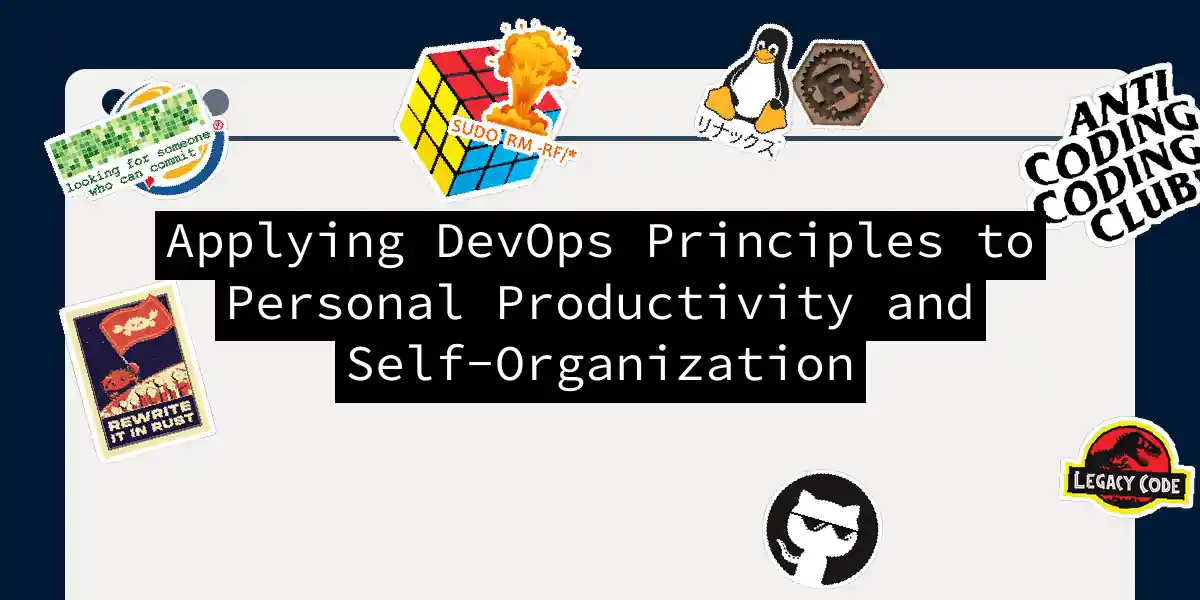The DevOps Revolution: From Teams to Individuals
In the world of software development, DevOps has become a buzzword, synonymous with efficiency, collaboration, and continuous improvement. But what if we told you that these principles can be just as powerful when applied to your personal productivity and self-organization? Let’s dive into how DevOps can transform not just your team’s workflow, but also your individual work habits.
Collaboration: The Heart of DevOps
In a traditional DevOps setup, collaboration between development and operations teams is key. This same principle can be applied to your personal workflow. Think of your different tasks and projects as separate teams that need to work together seamlessly.
For instance, if you’re working on a writing project and also managing a personal blog, treating these as interconnected tasks can help you stay organized. Set up regular check-ins with yourself to ensure that your writing and blogging tasks are aligned and supporting each other.
Automation: Freeing Up Time for What Matters
Automation is a cornerstone of DevOps, allowing teams to focus on high-value tasks by automating repetitive and mundane work. You can apply this principle to your personal life by automating routine tasks.
- Use Tools Like IFTTT or Zapier: Automate tasks such as saving email attachments to cloud storage, scheduling social media posts, or even setting reminders based on your calendar events.
- Scripting: If you’re comfortable with coding, write scripts to automate tasks like data entry, file organization, or even sending out regular reports.
For example, if you find yourself spending too much time organizing your digital files, you can write a simple script to automate the process. Here’s a basic example in Python:
import os
import shutil
# Source and destination directories
src_dir = '/path/to/source'
dst_dir = '/path/to/destination'
# Move files from source to destination
for filename in os.listdir(src_dir):
shutil.move(os.path.join(src_dir, filename), dst_dir)
Continuous Improvement: The Kaizen Mindset
DevOps emphasizes continuous improvement through feedback loops and iterative changes. This mindset can be incredibly powerful when applied to personal productivity.
- Set Up Feedback Loops: Regularly review your tasks and projects to see what’s working and what isn’t. Use tools like journals, spreadsheets, or even project management software to track your progress.
- Iterate and Adjust: Based on your feedback, make small changes to your workflow. This could be anything from adjusting your daily schedule to changing how you approach a particular task.
For instance, if you find that you’re consistently struggling to meet deadlines, analyze your workflow to identify bottlenecks. Maybe you need to allocate more time for planning or reduce distractions during work hours.
Customer-Centric Action: Understanding Your Needs
In DevOps, customer-centric action means understanding and responding to user needs quickly. When applied to personal productivity, this principle translates to understanding your own needs and priorities.
- Identify Your Goals: Clearly define what you want to achieve. Whether it’s completing a project, learning a new skill, or simply managing your time better, having clear goals helps you stay focused.
- Prioritize Tasks: Use the Eisenhower Matrix to categorize tasks into urgent vs. important and focus on the most critical ones first.
For example, if your goal is to write a book, prioritize your writing sessions over less important tasks like checking social media.
Streamlined Organization Culture: Simplifying Your Workflow
DevOps advocates for a streamlined organization culture where everyone works towards the same goal. In personal productivity, this means simplifying your workflow to reduce complexity and increase efficiency.
- Use a Single Task Management System: Instead of juggling multiple tools, use one comprehensive system like Trello, Asana, or Todoist to manage all your tasks.
- Minimize Context Switching: Group similar tasks together and complete them in one session to reduce the time spent switching between different tasks.
For instance, if you’re working on a project that involves both writing and design, try to complete all the writing tasks in one session before moving on to the design tasks.
Balanced Team Contribution: Leveraging Your Strengths
In a DevOps team, balanced contribution means everyone contributes their unique skills to achieve a common goal. When applied to personal productivity, this principle means leveraging your strengths to maximize efficiency.
- Identify Your Strengths: Understand what you’re good at and focus on those areas. If you’re a morning person, schedule your most challenging tasks for the morning.
- Outsource or Delegate: If possible, delegate or outsource tasks that are not within your skill set or that take up too much of your time.
For example, if you’re not good at graphic design but need a logo for your blog, consider hiring a freelancer to handle the design work.
Creative Collaboration: Working with Yourself
DevOps emphasizes creative collaboration between team members. When applied to personal productivity, this means working collaboratively with different aspects of yourself.
- Brainstorming Sessions: Hold brainstorming sessions with yourself to come up with innovative solutions to your problems.
- Mind Mapping: Use mind maps to visualize your ideas and see how different tasks and projects are interconnected.
For instance, if you’re stuck on a writing project, take some time to brainstorm ideas and then create a mind map to see how all the different elements fit together.
Conclusion
Applying DevOps principles to your personal productivity and self-organization is not just about adopting new tools or practices; it’s about embracing a mindset that values collaboration, automation, continuous improvement, and streamlined workflows. By integrating these principles into your daily routine, you can achieve a level of efficiency and productivity that you never thought possible.
So, the next time you’re feeling overwhelmed by your tasks, remember that you can be your own DevOps team. Collaborate with yourself, automate where possible, and continuously improve your workflow. And most importantly, keep your goals and needs at the forefront of everything you do.
